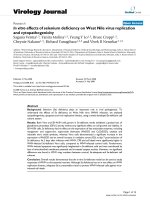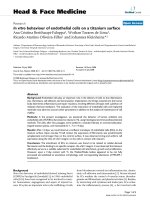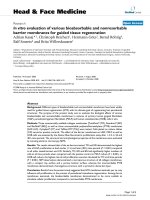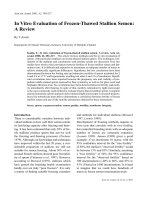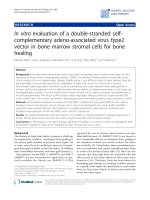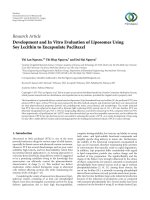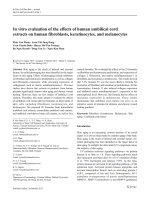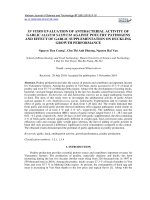In vitro evaluation of antibacterial activity of garlic Allium sativum against poultry pathogens and effect of garlic supplementation on duckling growth performance
Bạn đang xem bản rút gọn của tài liệu. Xem và tải ngay bản đầy đủ của tài liệu tại đây (546.81 KB, 8 trang )
Vietnam Journal of Science and Technology 57 (3B) (2019) 9-16
doi:10.15625/2525-2518/57/3B/14045
IN VITRO EVALUATION OF ANTIBACTERIAL ACTIVITY OF
GARLIC ALLIUM SATIVUM AGAINST POULTRY PATHOGENS
AND EFFECT OF GARLIC SUPPLEMENTATION ON DUCKLING
GROWTH PERFORMANCE
Nguyen Tien Cuong*, Chu Thi Anh Phuong, Nguyen Hai Van
School of Biotechnology and Food Technology, Hanoi University of Science and Technology,
1 Dai Co Viet Street, Hai Ba Trung, Ha Noi
*
Email:
Received: 29 July 2019; Accepted for publication: 3 November 2019
Abstract. Poultry production provides the source of protein and contributes an important income
for Vietnamese farmers. Among the poultry in Viet Nam, ducks account for 27.3 % of head of
poultry and even 55.7 % in Mekong Delta region. Along with the development of rearing ducks,
bacterial, viral and fungal diseases emerging in the last two decades caused bad economic effect
for poultry producer. Escherichia coli and Salmonella enterica act as major pathogenic bacteria
in duck. The aims of this study were to investigate the antibacterial activity of garlic Allium
sativum against E. coli, Staphylococcus aureus, Salmonella Typhimurium and to evaluate the
effect of garlic on growth performance of duck from 1-28 days old. The results indicated that
fresh garlic and dried garlic powder showed inhibitory effect against pathogenic tested strains at
the concentration of at least 2 % and 4 % w/v, respectively. The inhibition zones and the
minimal inhibitory concentration (MIC) values of garlic extract ranged from 11.3 - 28.3 mm and
0.02 - 0.2 g/ml, respectively. After 28 days of diet with garlic supplemented, the diet containing
2 % of fresh garlic showed significantly different in weight gain, feed conversion ratio, protein
efficiency ratio and average daily weight gain; whereas, the diet of adding of garlic powder in
basal diet only possessed a difference significant in feed consumption compared to the control.
The obtained results demonstrated the potential of garlic application in poultry production.
Keywords: garlic, duck, antibacterial activity, growth performance, poultry production.
Classification numbers: 1.2.1, 1.3.4
1. INTRODUCTION
Poultry production provides essential protein source and contributes important revenue for
Vietnamese farmers. The production of poultry, especially chickens and ducks, has been
increasing during the last two decades (broiler meat rising from 226 thousand tons in 1997 to
550 thousand tons in 2018). Among the poultry, ducks occupy 27.3 % of head of poultry in Viet
Nam and even 55.7 % in Mekong Delta region. At present, the consumption of duck egg and
meat is increasing in Viet Nam thanks to the low price and typical flavor [1]. Along with the
Nguyen Tien Cuong, Chu Thi Anh Phuong, Nguyen Hai Van
raising of rearing ducks, bacterial, viral and fungal diseases occurring in the last two decades
have been caused severe damage to the poultry producer. Escherichia coli and Salmonella spp.
act as major bacterial pathogens in duck. Nowadays, antibiotics are used to prevent and treat
bacterial infections in poultry industry. However, the overuse of antibiotic in livestock and
poultry production has led to the antimicrobial resistance which is one of the most serious threats
to global health [2]. Therefore, the Ministry of Agriculture and Rural Development of Viet Nam
is planning to impose a ban on all kinds of antibiotics in animal feed by 2020. Alternative
methods including the use of herbal products in poultry production are being evaluated [3]. Plant
extracts have been reported to various activities like anti-stress, growth promotion, appetite
stimulation, and enhancement of immune responses, anti-pathogen properties in animal due to
active compositions such as alkaloids, terpenoids, tannins, saponins, glycosides, flavonoids,
phenolics, steroids or essential oils [3]. A number of researchers over the years have investigated
the varying influences of different garlic forms in poultry production [4].
Garlic (Allium sativum), which belongs to the Alliaceae family, is one of important spices
in Viet Nam and throughout the world. Garlic contains many bioactive compounds such as
sulfur compounds (e.g. allicin) and polyphenols. Garlics extracts have been shown antimicrobial,
antioxidant and immunomodulatory effects [4, 5]. In Viet Nam, farmers have been used garlic in
poultry feed to attain the aforementioned results.
The aims of this study were to investigate the antibacterial activity of garlic A. sativum
against pathogenic bacteria in duck including Escherichia coli, Staphylococcus aureus,
Salmonella Typhimurium, and to evaluate the effect of garlic extract on growth performance of
duck from 1 to 28 days old.
2. MATERIALS AND METHODS
2.1. Materials
Garlic preparation: Fresh garlic A. sativum was purchased from Kinh Mon, Hai Duong.
Fresh garlic (moisture content ≈ 65 %) was dried at 50 oC for 2 days to moisture content of ≈
30%, then milled to obtain dry garlic powder. The fresh garlic extract was prepared by milling
the fresh garlic in sterilized water (ratio 1:3), whereas the dry garlic powder was extracted in
water (ratio 1:10). Both extractions were filtered using a 0.2 m pore size membrane to remove
all suspended solids (Minisart-Plus filters, Merck, Germany). After filtration, the extracts were
diluted in water and were used for antibacterial experiment.
Pathogenic bacteria: Three American Type Culture Collection (ATCC) strains were used
in this study including E. coli ATCC 25922, S. Typhimurium ATCC 14028 and S. aureus ATCC
25923.
Commercial feed was provided by Tan Phat animal feed, JSC.
2.2. Disc diffusion method
The antibacterial activities of garlic extract against E. coli ATCC 25922, S. aureus ATCC
25923, S. Typhimurium ATCC 14028 were investigated using the well diffusion agar method
described by Balouiri et al. [6]. Inhibition activity was determined by clear zone surrounding
each agar well. The test strains were inoculated into 10 ml of sterile nutrient broth (peptone 10
g/l, beef extract 10 g/l, sodium chloride 5 g/l), and incubated at 37 °C for 8 h. The cultures were
swabbed on the surface of sterile nutrient agar (peptone 10 g/l, beef extract 10 g/l, sodium
10
In vitro evaluation of antibacterial activity of garlic Allium sativum against poultry pathogens …
chloride 5 g/l, agar 15 g/l) plates using a sterile cotton swab. Agar wells were prepared with the
help of sterilized cork borer of 8 mm diameter. Using a micropipette, 100 l of different
concentrations of garlic extracts (100 %, 75 %, 50 %, 25 % and 10 %) were added to the wells.
The plates were incubated in an upright position at 37 °C for 24 h. The assays were performed in
triplicate. The inhibition zones including the diameter of the well was measured in mm with a
ruler and the results were recorded. The inhibition zones with diameter more than 8 mm were
considered as having antibacterial activity.
2.3. Antibacterial activity test
The MICs (Minimum Inhibitory Concentration) and MBC (Minimum Bactericidal
Concentration) of garlic extracts were determined using micro-broth dilution assay in 96-well
microplates as described previously with slightly modification [6]. The bacterial suspension of
106 CFU/ml was prepared from an overnight culture in NB medium by using previously
established Optical Density (OD) at 600 nm versus concentration standard curves. Each well
contained 20 µl of garlic extracts at different concentration and 180 µl of bacterial suspension.
Then, the plates were incubated at 37 oC for 24 h. MIC was determined as the lowest
concentration showing no visible growth. The MBC was determined by spreading 100 µl of the
cultures on NA plates and then incubated for 24 h at 37 oC. MBC was identified as the lowest
concentration showing no bacterial growth on agar plates. The assays were carried out in
triplicate. A positive control containing only the culture of bacterial and a negative control
containing the medium NB and garlic extract were performed under the same conditions.
2.4. Experimental diets
The experiment was carried out at the poultry farm at Son Tay, Hanoi. A total of 90
ducklings (vịt bầu cánh trắng) (1 day old, 45.0 ± 0.3 g) obtained from a hatchery (Ha Noi) and
then ducks were randomly allocated to nine cage (10 ducks per pen; three treatments and three
replicates). Three treatments including:
Diet 1 (D1): basal diet with no herbal plant (control), tap water,
Diet 2 (D2): basal diet supplemented with 2 % of garlic powder, tap water,
Diet 3 (D3): basal diet with no herbal plant added, drink water supplemented with 2 % of
fresh garlic.
The ingredients were blended thoroughly in a mixer and pelleted using a pellet-maker. The
feeding program involved in suppling starter diet (1-28 days old). The ducks were fed two times
per day by the prepared feed at rate of 30-35 % of the estimated duckling biomass per day.
Feeding rates were adjusted weekly based on estimates of biomass.
2.5. Determination of growth performance
The growth performance parameters were calculated according to the following formula:
Weight Gain (WG) = Final weight (g) – Initial weight (g);
Feed Conversion Rate (FCR) = Total feed (g)/Weight gain (g);
Average daily weight gain (ADG) = (Final weight – Initial weight)/Days;
Protein Efficiency Ratio (PER) = Weight gain (g)/Protein intake (g);
Feed Consumption (FC, % w/day) = (Feed given – Feed uneaten/W) × 100 %;
11
Nguyen Tien Cuong, Chu Thi Anh Phuong, Nguyen Hai Van
Feed cost for 1 kg WG (VND/kg) = FCR × price of feed.
2.6. Statistical analysis
All data obtained were analyzed by ANOVA using EXSTAT software. Differences between
means were determined and compared by Fisher’s test at the threshold of p < 0.05.
3. RESULTS AND DISCUSSION
3.1. Antibacterial activities of garlic extract
The antibacterial activities of garlic extract against pathogenic bacteria were presented in
Table 1 and Table 2.
Table 1. Inhibition zones (mm) of garlic against pathogenic strains.
Fresh garlic extract
Dry garlic powder extract
Concentration (% w/v)
10
5
4
2
10
5
E. coli
28.3 ± 1.5
20.0 ± 3.0
15.0 ± 1.0
22.0 ± 1.7
15.7 ± 2.5
S. Typhimurium
25.7 ± 1.5
18.3 ± 2.0
13.7 ± 0.5
16.3 ± 1.5
12.7 ± 0.5
S. aureus
18.6 ± 1.5
14.3 ± 1.5
12.3 ± 0.5
13.0 ± 1.7
11.6 ± 1.5
4
2
-
-
-
(-): Non-inhibitory effect.
Fresh garlic extract showed higher antibacterial activity than dry garlic powder extract
against test bacteria (Table 1 and Table 2). All test strains were inhibited by fresh garlic extract
and dry garlic powder extract up to concentration of 2 % and 4% w/v, respectively. The
inhibition zone was varied from 12.3 - 28.3 mm for fresh garlic extract and from 11.6 - 22.0 mm
for dry garlic powder extract. S. aureus was the most sensitive strain among three tested strains.
In addition, the higher MIC values were obtained in the case of dry garlic powder (0.2 g/ml)
compared to those of fresh garlic (0.02 - 0.04 g/ml) (Table 2). In all cases, garlic extract showed
bactericidal effect against test bacteria (MBC/MIC < 4).
Table 2. MIC and MBC (g dry matter/ml) values of garlic against pathogenic strains.
Strains
E. coli
S. Typhimurium
S. aureus
Fresh garlic extract
MIC
MBC
0.02 ± 0
0.02 ± 0
0.04 ± 0
0.04 ± 0
0.02 ± 0
0.02 ± 0
Dry garlic powder
MIC
MBC
0.2 ± 0
0.2 ± 0
0.2 ± 0
0.2 ± 0
0.2 ± 0
0.2 ± 0
The results obtained were in accordance with those of previous studies. Garlic and its
extracts have been shown to inhibit numerous microorganisms, including bacteria (Bacillus,
Escherichia, Mycobacterium, Pseudomonas, Staphylococcus and Streptococcus), fungi, and
yeasts. Durairaj et al. reported that aqueous garlic extract at different pH value (5.8 - 9.0)
12
In vitro evaluation of antibacterial activity of garlic Allium sativum against poultry pathogens …
possessed an inhibition zones ranged from 12.0 - 33.0 mm, 15.0 - 44.0 mm and 0 - 33.0 mm
against E. coli, S. Typhimurium and S. aureus, respectively [7]. In addition, garlic extract at
0.04 - 0.10 mg/ml concentration inhibited the growth of S. aureus with the inhibition zones
ranged from 15 - 23 mm [8]. However, Gull et al. reported higher inhibitory effect of garlic
extract in Lahore, Pakistan (MIC = 0.1 mg/ml) than our study in the case of E. coli [9]. This may
be due to the garlic preparation, different concentrations of the active compounds present in the
extract and their interactions in the culture media. Several mechanisms have been proposed for
the antibiotic activity of garlic, including modulation of sulfhydryl enzymes, inhibition of RNA
synthesis, and partial inhibition of DNA and protein synthesis [10]. Recently, Booyens et al.
(2014) investigated the antibacterial mechanism of crude garlic clove extract by using electron
microscopy. The micrographs obtained showed the change of morphology such as cell
elongation, distorted cells with bulbous ends and the condensation of cytoplasmic material,
disintegration of membranes, loss of structural integrity of garlic clove extract-treated cells and
leading to the cell death [11].
The antibacterial activity of garlic is widely attributed to allicin. Previous studies
demonstrated that allicin blocked the action of bacterial enzymes by reacting with thiols,
inhibited RNA synthesis and thereby inhibited the growth of the micro-organism [11, 12].
However, this constituent is photo- and thermo-sensitive, and easily metabolized into various
compounds. Therefore, dry garlic powder possessed lower antimicrobial activity than fresh
garlic.
3.2. Effect of garlic extract on growth parameters of duckling
As the antibacterial activity of garlic extract against poultry pathogen bacteria was
demonstrated, our study continued to evaluate the effect of their extract on the growth of
duckling. The previous study concluded that the incorporation of phytogenic substances in feed
could improve the growth performance and thus decrease mortality rate of birds [13].
1 day old duckling
28 days old duckling
Figure 1. Duckling experimental diets.
The growth performance parameters of duckling fed experimental diets were presented in
Figure 1 and Table 3. No adverse effect was observed for duckling during 28 days-feeding
period. At the end of the experiment, significant differences were observed in the Weight Gain
(WG), Feed Conversion Rate (FCR), Protein Efficiency Ratio (PER) and Average daily weight
gain (ADG) duck fed D3 and D1 (p > 0.05; Table 3). The result of the WG indicated that D3
gained the highest weight (1012.9 ± 31.8 g), followed by D2 (956.0 ± 21.3 g) and D1 (894.6 ±
42.5 g). FCR of D3 groups (2.80 ± 0.13), on the other hand, showed lowest value whereas the
13
Nguyen Tien Cuong, Chu Thi Anh Phuong, Nguyen Hai Van
D1 exhibited the highest value (2.47 ± 0.06). The D2 showed highest FC value, following by D1
and D2, no significant difference was observed between D1 and D3 (Table 3).
Table 3. Growth parameters of duckling after 28 days of feeding with garlic supplemented.
WG (g)
FCR (g/g)
PER (g/g
protein)
ADG (g/bird/day)
FC (g/bird)
D1
894.6a ± 42.5
2.80a ± 0.13
2.03a ± 0.10
31.95a ± 1.52
2520.0a ± 5.8
D2
956.0ab±21.3
2.73a ± 0.09
2.10a ± 0.07
34.14ab ± 0.76
2607.6b ± 23.9
D3
1012.9b ± 31.8
2.47b ± 0.06
2.31b ± 0.06
36.17b ± 1.14
2503.9a ± 28.0
Treatment
WG: Weight Gain, FCR: Feed Conversion Ratio, PER: Protein Efficiency Ratio, ADG: Average Daily
Weight gain, FC: Feed Consumption; Values with different letters (a-b) within the same columns differ
significantly (p < 0.05) by Fisher’s test.
The results of the present study showed that 2 % garlic powder supplementation in diet had
no significant effects whereas supplementation of 2 % fresh garlic in water led to significant
effects on the growth performance of duck. As reported in literature, phytogenic substances are
supposed to increase performance of birds by stimulating secretion of digestive enzymes,
leading to enhanced digestion and absorption. Furthermore, the presence of active ingredients
and phenolic compounds can reduce numbers of intestinal pathogens, thus minimizing nutrient
loss and improving performance. Elagib et al. concluded that the incorporation of garlic at 3 %
in feed significantly enhanced growth and performance of broiler chicks without any side
effects, and therefore decreased mortality rate [13]. Using 0.3 % of garlic to the basal
experimental diet on the broiler chicks resulted in a significant positive effect on birds’ growth
performance, mortality rate and immune response [14]. Additionally, garlic is rich in calcium,
phosphorus, carbohydrates, contains many valuable compounds and vitamins and has a high
nutritive value. In addition, garlic and its main active component, allicin, were demonstrated to
improve the immunological parameter of poultry such as reduce low density lipoprotein,
triglyceride and cholesterol in serum; decrease serum and liver cholesterol levels; reduce
oxidative stress [4].
Table 4. Feed cost of garlic supplemented diets.
Parameters/pens
D1
D2
D3
Price of basal diet
10.000
10.000
10.000
Price of garlic*
0
1440
600
Price of diet
10.000
11.440
10.600
Feed cost
28.000
31.231
26.182
Unit: VND; (*) Price of garlic = Amount of fresh garlic used in 1kg of feed * 10.000 VND/kg
The feed cost per kilogram body WG in D1, D2 and D3 were 28.000, 31.231 and 26.182
VND, respectively (Table 4). The feed cost per kilogram body WG of control group D1 was
6.49 % higher than the treatment D3 group and was 10.35 % lower than the treatment D2 group.
Feed is the major component of total costs of duck rearing. The change of feed cost was due to
14
In vitro evaluation of antibacterial activity of garlic Allium sativum against poultry pathogens …
the difference of the FCR. In the current study, the FCR of two treatment groups were lower
compared to the control (Table 3). However, due to the higher cost of garlic, rate feed cost is
different between groups. The results indicated that fresh garlic showed positive effect in the
cost of production.
4. CONCLUSIONS
In conclusion, the current study demonstrated the inhibitory effect of the garlic extract on
pathogenic bacteria. The fresh garlic exhibited higher antibacterial activity than dry garlic
powder. The zone of inhibition and the MIC values ranged from 11.6 – 28.3 mm and 0.02 – 0.2
g/ml, respectively. Dietary of fresh garlic supplemented in water had significant effects on the
growth performance of duckling including weight gain, feed conversion ratio, protein efficiency
ratio, and average daily weight gain. Due to wide distribution of garlic, their extract could be
proposed to apply at industrial scale in order to strengthen the sustainable development in
poultry production.
REFERENCES
1.
Men B. X. - Duck farming systems and avian influenza in the Mekong delta of Viet Nam,
FAO Smallholder Poultry Production Paper 1 (2010) 1-8.
2.
Nhung N. T., Chansiripornchai N., Carrique-Mas J. J. - Antimicrobial resistance in
bacterial poultry pathogens: a review, Frontiers in Veterinary Science 4 (2017) 126.
3.
Kuldeep D., Shyma K. L., Saminathan M., Hari A. S., Karthik K., Ruchi T., Rifat U. K.,
Mahmoud A., Mayada R. F., Gazi M. A., Vito L., Vincenzo T. - Multiple beneficial
applications and modes of action of herbs in poultry health and production-A review,
International Journal of Pharmacology 11 (2015) 152-176.
4.
Puvača N., Ljubojević D., Kostadinović L., Lukač D., Lević J., Sanja T. P., Djuragic O. Spices and herbs in broilers nutrition: Effects of garlic (Allium sativum L.) on broiler
chicken production, World's Poultry Science Journal 71 (2015) 533-538.
5.
Mansoub N. H. - Comparative effects of using garlic as probiotic on performance and
serum composition of broiler chickens, Annals of Biological Research 2 (3) (2011)
486-490.
6.
Balouiri M., Sadiki M., Ibnsouda S. K. - Methods for in vitro evaluating antimicrobial
activity: A review, Journal of Pharmaceutical Analysis 6 (2) (2016) 71-79.
7.
Durairaj S., Srinivasan S., Lakshmanaperumalsamy P. - In vitro antibacterial activity and
stability of garlic extract at different pH and temperature, Electronic Journal of Biology 5
(1) (2009) 5-10.
8.
Khashan A. A. - Antibacterial activity of garlic extract (Allium sativum) against
Staphylococcus aureus in vitro, Global Journal of Bio-Science and Biotechnology 3 (4)
(2014) 346-348.
9.
Gull I., Saeed M., Shaukat H., Aslam S. M., Samra Z. Q., Athar A. M - Inhibitory effect
of Allium sativum and Zingiber officinale extracts on clinically important drug resistant
pathogenic bacteria, Annals of Clinical Microbiology and Antimicrobials 11 (1) (2012) 8.
15
Nguyen Tien Cuong, Chu Thi Anh Phuong, Nguyen Hai Van
10. Sivam G. P., Lampe J. W., Ulness B., Swanzy S. R., Potter J. D. - Helicobacter pylori - in
vitro susceptibility to garlic (Allium sativum) extract, Nutrition and Cancer (1997)
118-121.
11. Booyens J., Labuschagne M. C., Thantsha M. S. - In vitro antibacterial mechanism of
action of crude garlic (Allium sativum) clove extract on selected probiotic Bifidobacterium
species as revealed by SEM, TEM, and SDS-PAGE analysis, Probiotics and
Antimicrobial Proteins 6 (2) (2014) 82-87.
12. Eja M. E, Asikong B. E., Abriba C., Arikpo G. E., Anwan E. E., Enyi-Idoh K. H. - A
comparative assessment of the antimicrobial effects of garlic (Allium sativum) and
antibiotics on diarrheagenic organisms, Southeast Asian Journal of Tropical Medicine and
Public Health 38 (2) (2007) 343-348.
13. Elagib H. A. A., El-Amin W. I. A., Elamin K. M., Malik H. E. E. - Effect of dietary garlic
(Allium sativum) supplementation as feed additive on broiler performance and blood
profile, Journal of Animal Science Advances 3 (2) (2013) 58-64.
14. Fadlalla I. M. T., Mohammed B. H., Bakhiet A. O. - Effect of feeding garlic on the
performance and immunity of broilers, Asian Journal of Poultry Science 4 (2010)
182-189.
16
